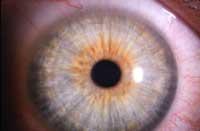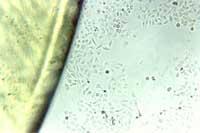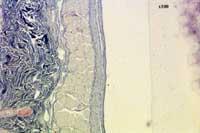Intraocular contact lenses
Before you start talking about contact lenses, would you define what biomaterials are? In
general, biomaterial is any material in contact with the body. Normal contact lenses, strips, dental implants, bone prostheses, heart valves, adhesives, surgical material,... Some have low level of contact with the body, such as bandage, and others very high as heart valves. Biomaterials should be biocompatible, i.e. not produce body rejections and meet stricter requirements depending on the degree of contact.
Do these features depend on the application?
Yes, depending on the fabric one material or another is used. In general, ceramic materials, polymers and metallic materials such as biomaterials are used, selecting one or another type of materials to use.
One of these applications is intraocular contact lenses. In this project you are collaborating with the UPV. What is the goal?

In this case the objective is double. On the one hand, we have to get into the eye and look for the most suitable material that does not harm, and on the other hand, this material should be useful to improve vision. The eye is a very complex organ and it is not easy to work with biocompatibility.
So you are investigating something more complex than conventional lenses.
Currently there are two types of contact lenses on the market, which are placed and removed, and intraocular lenses. The latter are placed very internally in the lens to cure the cataract. The lenses we propose would not be placed so inside, but under the cornea. The cornea is on the outside of the eye and is the first lens the eye has. The line we investigated would be placed under the cornea.
When placed inside, they must meet more stringent characteristics than contact lenses, right?
Yes, the material must be more porous and permeable to both water and certain waste. The cornea does not have a blood vessel, food reaches it by absorption, so it must be removed by contact lenses. And, of course, the material must be transparent. We are researching the same material used in conventional lenses, but in our case we have enough more water to make it more porous and permeable. The issue is that this generates transparency issues. Our job is to find the balance between all these characteristics. A sufficiently porous, transparent, elastic, resistant and permeable material must be found.
And no problem of rejection?

The goal is to prepare material that the body does not consider strange. The body tends to expel the outside person because it is strange. Hence the search for porous material. More water, more porosity of the material and less risk of rejection to avoid edema and the resulting extrusion.
In addition to looking for the right material, we want this material to be active. Proteins and enzymes are involved in the rejection process and, if influenced, compatibility can be improved. In previous research we worked with a chemical compound that acts on these enzymes. By adding this compound, the material has been functioned and therefore more compatible, reducing rejection problems.
Is it a complex cut to insert into the eye?
No, not in principle. The cut is small as the cornea is of fine bark. Make a small cut, insert the flexed lentilla, place it and form the eye smoothly.
And would they serve to treat any visual problems?
Yes, we seek and ophthalmologists working with us see it possible; the technique itself and the material allow it. Theoretically, intracorneal contact lenses may be useful for correcting myopia, farsightedness, astigmatism, and presbyopia. But there is a lot of work ahead.
Today, many people perform laser operations to solve vision problems. What do intraocular lenses offer?

These things are usually not white or black. Ophthalmologists have many problems and it is always interesting to expand the range of possibilities. In addition, intraocular lenses could be applied in more cases than the laser.
How long have you been with this research?
We have been working with this project for two years, but it must be borne in mind that the project is the result of an investigation of three years earlier.
At what point is the research?
Two years to reach the end of a project of these characteristics. In these two years we have researched and improved the characteristics of the material. We have achieved the most suitable material possible and from now on we start working in detail, we are in the optimization phase. As for biocompatibility, we have found that it is compatible with cells, but we expected it because we started from a biomaterial. We have also started working with animals. From now on it will be necessary to add all this work and perform more tests.
Will it still take a long time to test with humans?
Yes, yes, much. In addition, research never ensures that it will be tested on humans. The project has a duration of three years and once completed an evaluation and see where to go. It may be necessary to follow another path. Obtaining valuable lenses inside the cornea has been the subject of several previous attempts, but the material has always generated problems. The materials are making great strides and we are working on it. Once the project is completed, a thorough analysis will be carried out by the entire team and the direction of the research will be decided.
In any case, I think we have at least opened the way. On the other hand, such projects are interdisciplinary and collaboration is very important. In this sense, these works are also very enriching.
Interview on the radio program Euskadi Norteko Ferrokarrilla (18-12-2002).
Buletina
Bidali zure helbide elektronikoa eta jaso asteroko buletina zure sarrera-ontzian











